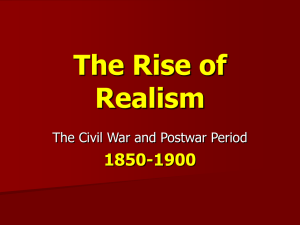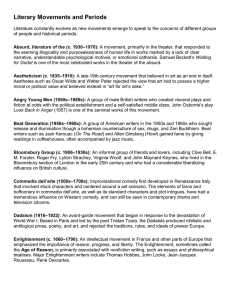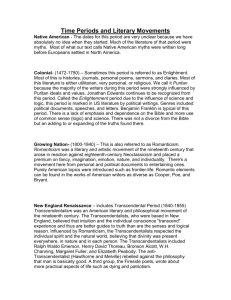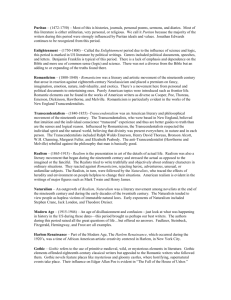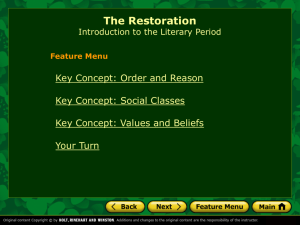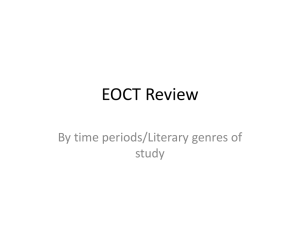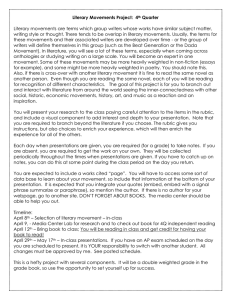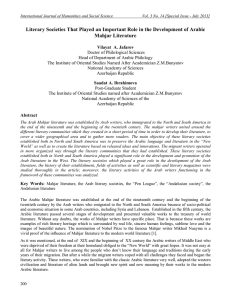Presentation
advertisement
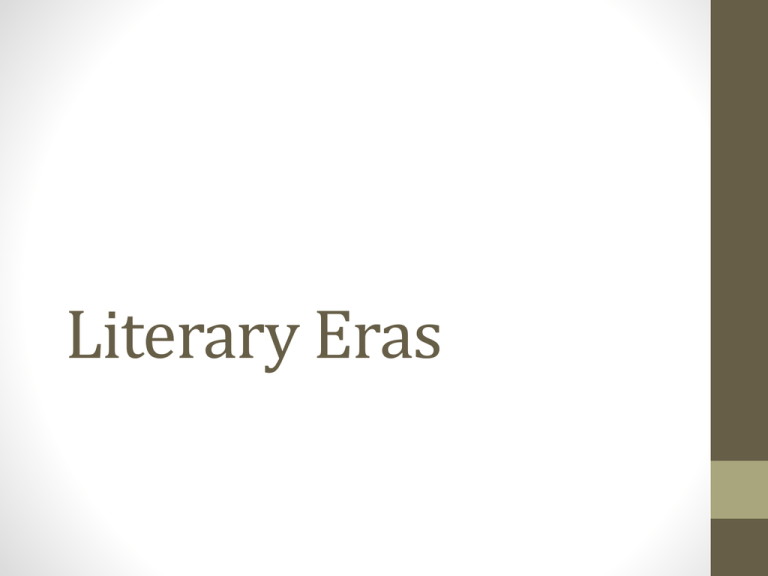
Literary Eras Middle English 1066-1500 • transitional period between Anglo-Saxon and modern English • cultural upheaval that followed the Norman Conquest of England, in 1066 • secular literature: • • • • ballads, chivalric romance allegorical poems religious plays • Chaucer’s The Canterbury Tales is the most celebrated work of this period. 1500–1650, The Elizabethan Era • was a flourishing period in English literature, particularly drama, that coincided with the reign of Queen Elizabeth I • included writers such as: • • • • • • Francis Bacon, Ben Jonson, Christopher Marlowe, William Shakespeare, Sir Philip Sidney Edmund Spenser. 1660–1790 The Enlightenment • • • • intellectual movement in France and other parts of Europe emphasized the importance of reason, progress, and liberty. Sometimes called the Age of Reason Associated with nonfiction writing, such as essays and philosophical treatises. • Major Enlightenment writers include Thomas Hobbes, John Locke, Jean-Jacques Rousseau, René Descartes. 1764–1820 Gothic Fiction • late-18th-century literature that featured brooding, • mysterious settings and plots and set the stage for what we now call “horror stories.” • Horace Walpole’s Castle of Otranto, set inside a medieval castle, was the first major Gothic novel. • Later, the term “Gothic” grew to include any work that attempted to create an atmosphere of terror or the unknown, 1798–1832, Romanticism • literary and artistic movement that reacted against the restraint and universalism of the Enlightenment. • The Romantics celebrated spontaneity, imagination, subjectivity, and the purity of nature. • Notable English Romantic writers include Jane Austen, William Blake, Lord Byron, Samuel Taylor Coleridge, John Keats, Percy Bysshe Shelley, and William Wordsworth. • Prominent figures in the American Romantic movement include Nathaniel Hawthorne, Herman Melville, Edgar Allan Poe, William Cullen Bryant, and John Greenleaf Whittier. 1830–1900, Realism • is a loose term that can refer to any work that aims at honest portrayal over • sensationalism, exaggeration, or melodrama. Technically, realism refers to a late-19th-century literary movement— primarily French, English, and American—that aimed at accurate detailed portrayal of ordinary, contemporary life. Many of the 19th century’s greatest novelists, such as Honoré de Balzac, Charles Dickens, George Eliot, Gustave Flaubert, and Leo Tolstoy, are classified as realists. Naturalism can be seen as an offshoot movement: an intensification of realism. 1832–1901, Victorian Era • was a period of English history between the passage of the first Reform Bill • (1832) and the death of Queen Victoria (reigned 1837–1901). Though remembered for strict social, political, and sexual conservatism and frequent clashes between religion and science, the period also saw prolific literary activity and significant social reform and criticism. Notable Victorian novelists include the Brontë sisters, Charles Dickens, George Eliot, William Makepeace Thackeray, Anthony Trollope, and Thomas Hardy, while prominent poets include Matthew Arnold; Robert Browning; Elizabeth Barrett Browning; Gerard Manley Hopkins; Alfred, Lord Tennyson; and Christina Rossetti. 1835–1860, Transcendentalism • was an American philosophical and spiritual movement, based in • New England, that focused on the primacy of the individual conscience and rejected materialism in favor of closer communion with nature. Ralph Waldo Emerson’s “SelfReliance” and Henry David Thoreau’s Walden are famous transcendentalist works. 1835–1910, Aestheticism • was a late-19th-century movement that believed in art as an end in itself. Aesthetes such as Oscar Wilde and Walter Pater rejected the view that art had to possess a higher moral or political • value and believed instead in “art for art’s sake.” 1865–1900, Naturalism • was a literary movement that used detailed realism to suggest that social conditions, heredity, and environment had inescapable force in shaping human character. Leading writers in the • movement include Émile Zola, Theodore Dreiser, and Stephen Crane. 1890s–1940s, Modernism • was a literary and artistic movement that provided a radical break with • traditional modes of Western art, thought, religion, social conventions, and morality. Major themes of this period include the attack on notions of hierarchy; experimentation in new forms of narrative, such as stream of consciousness; doubt about the existence of knowable, objective reality; attention to alternative viewpoints and modes of thinking; and self-referentiality as a means of drawing attention to the relationships between artist and audience, and form and content. 1918–1930, The Harlem Renaissance • was a flowering of African-American literature, art, and • music during the 1920s in New York City. • W. E. B. DuBois’s The Souls of Black Folk anticipated the movement, which included Alain Locke’s anthology The New Negro, Zora Neale Hurston’s novel Their Eyes Were Watching God, and the poetry of Langston Hughes and Countee Cullen. 1930–1970, The Theater of the Absurd • was a movement, primarily in the theater, that • responded to the apparent illogicality and purposelessness of human life in works marked by a lack of clear narrative, understandable psychological motives, or emotional catharsis. Samuel Beckett’s Waiting for Godot is one of the most celebrated works in the theater of the absurd. 1945–present, Postmodernism • is a notoriously ambiguous term, especially as it refers to literature, • postmodernism can be seen as a response to the elitism of high modernism as well as to the horrors of World War II. Postmodern literature is characterized by a disjointed, fragmented mash-up of high and low culture that reflects the absence of tradition and structure in a world driven by technology and consumerism. Julian Barnes, Don DeLillo, Toni Morrison, Vladimir Nabokov, Thomas Pynchon, Salman Rushdie, Alan Moore, and Kurt Vonnegut are among many who are considered postmodern authors. 1950s–1960s, The Beat Generation • was a group of American writers in the 1950s and 1960s who • sought release and illumination though a bohemian counterculture of sex, drugs, and Zen Buddhism. Beat writers such as Jack Kerouac (On the Road) and Allen Ginsberg (“Howl”) gained fame by giving readings in coffeehouses, often accompanied by jazz music. 1950s–present, Postcolonial literature • is literature by and about people from former European • colonies, primarily in Africa, Asia, South America, and the Caribbean. This literature aims both to expand the traditional canon of Western literature and to challenge Eurocentric assumptions about literature, especially through examination of questions of otherness, identity, and race. Prominent postcolonial works include Chinua Achebe’s Things Fall Apart, V. S. Naipaul’s A House for Mr. Biswas, and Salman Rushdie’s Midnight’s Children. Edward Said’s Orientalism (1978) provided an important theoretical basis for understanding postcolonial literature.

